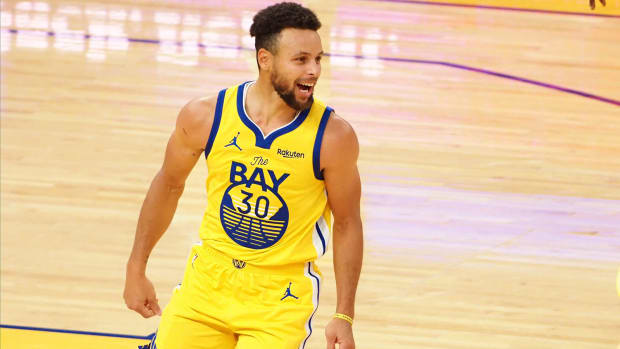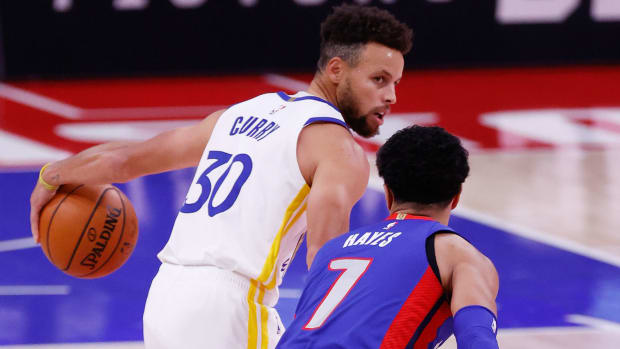A day after scoring a new career high with 62 points, it is clear Stephen Curry has a lot of great basketball left. But what does a post-Curry era in Golden State look like?
The NBA is a never-ending series of events that separate prologues from climaxes and downfalls. For the Golden State Warriors, Klay Thompson’s torn Achilles is a seismic and ominous example that turned the organization’s relatively concrete position into pudding.
The full aftermath isn’t yet known—Thompson may look good as new the next opening night or, as a 31-year-old who from 2015 to 2019 logged nearly 500 more possessions than every other player, may not be able to stay in front of point guards or have the same first step—but barring an unlikely 2021 playoff run that inspires confidence in their flawed roster, the injury will likely impact how the organization views its long-term relationship with Steph Curry.
Before this season began, Curry was eligible for an extension that would’ve tacked on an additional three years and $156 million to the two years left on his current deal, but despite Curry publicly stating his desire to spend the rest of his career with the same team, no agreement was reached, even as several other stars signed extensions of their own.
The NBA is a precarious landscape; the fealty stars once showed towards their employer—and vice versa—has evaporated. Remove all emotion from the equation then ask yourself why Warriors owner Joe Lacob—a man who reportedly tried to low-ball Curry on his previous deal —would show blind loyalty to an aging guard with a concerning injury history?
It’s premature, if not blasphemous, to realistically expect a trade to happen anytime soon. Curry’s stature is unparalleled; there’s no apparent animosity between him and the Warriors; he isn’t disgruntled and hasn’t been coddled in a way that obliterates self-awareness. But there are harsh realities to consider.
A two-time MVP and three-time champion who forever changed how basketball is played, enjoyed, and analyzed, most of Curry’s last five years were an unwavering eruption that covered every other team in ash. He immolated the competition while accelerating the sport’s strategic evolution. One day after dropping a new career high with 62 points, Curry still has the air of inevitability—liquid heat bursting from fingertips that can silence an opposing run as easily as it can extend his own. The man eventizes every possession like nobody else who’s ever dribbled a basketball.
He’s also three months shy of his 33rd birthday, mired in a 12th season that’s disintegrated the line between conqueror and hunted. After five games the Warriors have been lambasted by nearly 15 points per 100 possessions (aka just good enough for 10 wins). Their offense is 30th out of 30 teams. It’s early. Three-point luck hasn’t been on their side and they’ll eventually convert way more than 53 percent of their attempts at the rim. But the Warriors don’t justify the largest luxury tax bill in the league. Two of their three max contracts won’t expire until at least 2023—a year after Curry’s—to say nothing of Draymond Green’s own $100 million deal. (If Green exercises his player option, he and Thompson will earn a combined $70 million in 2024. Both turn 34 that season. Throw in James Wiseman’s team option and that’s $80 million for three players who are not named Curry.)

You can’t blame Golden State for not wanting to lock Curry in and forfeit their own flexibility. Even as the last of a dying breed inside an increasingly transient NBA, with a bond to one team that’s unrelatable to every other player born after the late 1980’s, franchises that prioritize winning don’t pay for nostalgia; to guarantee a 37-year-old $56 million without any way to ensure even a playoff berth would be extraordinary.
(The Portland Trail Blazers paying Damian Lillard $54 million that same season is the only comparison, but he’s almost 2.5 years younger than Curry and on a team closer to the Finals than Golden State is.)
Age and expected decline are surely to blame for any hesitation on the Warriors part. And to a lesser degree, so might be how the league has stylistically caught up to everything that makes Curry great. He led and inspired a revolution like only someone from the future can. And that’s essentially what he was, fearlessly embracing his own superpower in a way that lifted him above everybody else.
During his unanimous MVP season in 2016, Curry made an NBA record 402 three-pointers—or, viewed another way, at least half as many threes as 23 whole teams. Two years later, James Harden drilled a season-high 378 threes, the second most ever. Also, it was “only” at least half as many threes as one other team (the Chicago Bulls).
In other words, this was not basketball’s version of Greek fire, which disappeared in the 13th century because its secrets were guarded too well by those who used it. The best teams have either embraced the three-point line’s value or installed better defenses to protect themselves from it. The singular advantage Curry had cannot be replicated, even if he somehow produced as he once did.
So, if championship contention is the goal, how does Golden State get there with talent that doesn’t come close to reflecting its own payroll? The Warriors have hemorrhaged more instinctual knowhow and generational talent faster than any team in recent history. Kelly Oubre is not Klay Thompson, Juan Toscano-Anderson is no Andre Iguodala, and Andrew Wiggins does not belong to the same species as Kevin Durant.
To look at it from Curry’s perspective, if no max extension is offered next offseason either, the thought of gauging greener pasture as an unrestricted free agent won’t be lunacy. The man has a lot of great basketball left. It’s conceivable Golden State squanders it.

A lot can change over the next two seasons, but losing Curry for nothing would severely damage an organization that prematurely christened itself “light years ahead of probably every other team in structure, in planning, in how we’re going to go about things,” which is what Lacob claimed in infamy four years ago.
The Warriors either need to find a new way to play (Curry is already finishing more possessions as a pick-and-roll ball-handler than he did in any season since 2016), upgrade their talent, or, before it’s too late, move on from the most beloved and transcendent figure in franchise history.
There’s a chance Golden State can compete for another championship with Curry as its most expensive player, but the path to get there is littered with optimistic assumptions and stormy variables. If Wiseman looks like the Rookie of the Year and then takes a significant sophomore leap; Green and Thompson enter 2022 in peak condition; Steph remains one of the NBA’s 10 best players; and the top 3-protected first-round pick Minnesota owes Golden State in 2021 (it’s unprotected in 2022) manifests immediate contribution, either via trade or with a special prospect who can help right away, then the Warriors will be in a pretty good spot.
But even if all that happens, everyone needs to stay healthy and Lacob can’t express any concern with a spiraling luxury tax bill. According to Spotrac, this year’s payment is on track to be $137.1 million. The next highest team is the Brooklyn Nets—an actual contender—at $57.4 million. Next year, Golden State’s tax bill is again estimated to cross the $100 million mark.
If Curry finishes this season at an All-NBA level the Warriors can always offer him a max extension that goes up to four more years. If Wiseman becomes a two-way monster, Thompson returns without skipping a beat, and Wiggins + Minnesota’s first-round pick can be flipped for someone like Bradley Beal or Pascal Siakam, the Warriors will be formidable. Even if not, there’s always the chance Curry gives Golden State a hometown discount and/or they squeeze younger assets out of Green’s contract and go from there.
But that scenario doesn’t seem particularly likely. Not every contract means the same thing to every team. The Warriors decided not to tie themselves to Curry’s late 30’s by committing $200+ million before they had to. That doesn’t mean another team wouldn’t spring at the chance to do so. And even though every superstar trade takes place in its own silo, Milwaukee’s willingness to surrender three first-round picks for Jrue Holiday makes a hypothetical package for Curry seem impossible. We’re talking about an ocean of assets: Young star(s), multiple draft picks, and, since the Warriors might want to avoid bottoming out entirely, quality win-now production.
Those circumstances limit potential suitors more than any conceivable fit issues. But the Philadelphia 76ers, Boston Celtics, Dallas Mavericks, Miami Heat, Denver Nuggets, Toronto Raptors, New Orleans Pelicans, Atlanta Hawks, and roughly 15 other teams would all try to elbow themselves into the bidding. There are obvious parallels to Harden’s current trade demand, in both prestige and remaining years left on their respective contracts, but Curry’s ability and willingness to elevate teammates off the ball makes him a much smoother fit in any environment. He’s the greatest shooter of all time and will be so for the foreseeable future.
Right now, the financial commitment to Thompson, Wiggins, and Green makes a full-on rebuild tricky. But what if the Nuggets offer Michael Porter Jr. Monte Morris, and Gary Harris next summer? The Nuggets wouldn’t be perfect, but they would likely go from pseudo-contender to title favorite, and a Curry, Jamal Murray, Nikola Jokic trio would likely yield the most dangerous and aesthetically pleasurable offense in NBA history.
Not to assume the holdup in any Harden deal is coming from Philadelphia’s end, but there might be even less hesitation on Daryl Morey’s part to exchange Ben Simmons and additional assets for the one player who most tortured his tenure with the Rockets.
The Miami Heat? Have Tyler Herro, take Duncan Robinson, and please gouge all of our draft picks. Hypothetically, what happens if the Warriors offer Curry to the Utah Jazz for Donovan Mitchell, or the Boston Celtics for Jaylen Brown? How about if they call up the New Orleans Pelicans and ask for Brandon Ingram and a couple draft picks?
Curry’s salary, age, and sentimental draw make any transaction difficult. And the most logical deals wouldn’t even be possible until this offseason, when Curry would only have one year left on his contract. But the exercise is valid, given Thompson’s injury, the team’s current state, and the organization’s future prospects. It's hard watching a proud player chase his own ghost. Curry isn’t that yet, but a hefty commitment on Golden State’s end wouldn’t bring either side closer to the mountaintop.
The NBA is a frosty business and nothing lasts forever. Moving on a year too soon is better than being backed into a corner for half a decade. For the Warriors, a post-Curry era wouldn’t be a disaster if they don’t let it become one. Free agents will want to live in San Francisco, and Wiseman looks like a real building block. Depending on what they get back in a potential trade, and what they do with the contracts they still have, their next era of prosperity may come quicker than it probably would for most other teams. But extremely difficult decisions would have to be made for that to happen.
Curry wants to spend his entire career with the same team and that’s genuinely sweet. But there are several reasons why so few players actually do, and he isn’t immune to any of them. If winning at the highest level is not practical, or the money isn’t right, Curry and Golden State may split up. To do so would be as mutually beneficial as these things can be.